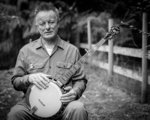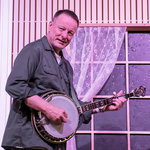Danny Barnes, banjo player extraordinaire, has lived in Jefferson County for 18 years, but plays only rarely at local venues.
"My wife and I just like the climate here," he said. "I don't …
This item is available in full to subscribers.
We have recently launched a new and improved website. To continue reading, you will need to either log into your subscriber account, or purchase a new subscription.
If you had an active account on our previous website, then you have an account here. Simply reset your password to regain access to your account.
If you did not have an account on our previous website, but are a current print subscriber, click here to set up your website account.
Otherwise, click here to view your options for subscribing.
* Having trouble? Call our circulation department at 360-385-2900, or email our support.
Please log in to continue |
|


Danny Barnes, banjo player extraordinaire, has lived in Jefferson County for 18 years, but plays only rarely at local venues.
"My wife and I just like the climate here," he said. "I don't interface too much when I'm here ... don't go out much when I'm here. Because I have to go out in Western Europe, Canada and the domestic United States, I keep a low profile. I'm here really to work."
He practices "four or five hours a day," he said. "I never realized how hard someone has to work, with running a business and trying to make art on top of that; I never realized how hard it was going to be," he said. "You see someone play, and it looks like they're just hanging around having a good time ... but it takes so much work."
His work has paid off. He received $50,000 for winning the 2015 Steve Martin Prize for Excellence in Banjo and Bluegrass.
Martin said in a press release, “Danny is a real innovator, and we want to make sure innovation gets honored over the course of the prize. He plays three-finger and he’s also not afraid to strum like an old banjo. You rarely see that, someone using banjo in all its capacities.”
Barnes' 2015 album, "Got Myself Together (Ten Years Later)" is an acoustic version of his original "Get Myself Together" (2005). That album "was well received, but people couldn't get it. They're out of print. It just like vaporized," he said. Friends at Eight 30 Records suggested he redo it acoustically. It also has a bonus-track re-recording of his former band the Bad Livers' song “I'm Convicted,” which is an example of how Barnes combines banjo with electronic music. "I'm Convicted" has a solid electronic beat, overlaid with banjo, and lyrics you can sink your heart into.
BARNYARD ELECTRONICS
Barnes calls his aesthetic "barnyard electronics." It combines "older American music with contemporary recording techniques."
He's "done a lot of homework in traditional American form," and tries to "put those two almost together – bluegrass and electronic music."
"If it was on a piano, it'd be the high note and the low note," he said. "They're like different parts of the library."
He's extremely knowledgeable about the history of music; he holds a bachelor's degree in audio recording from the University of Texas, and unlike some degree-holders, he said, "I use my thing every day."
While he was at UT, in the late 1970s, there was "an explosion of punk rock," Barnes said. "I got really into that music." He "got interested in noise music and avant-garde music through studying the history of recorded music."
He learned about contemporary composition – the "spectral" techniques of Tristan Murail – "really the latest thing to happen in composed music" – and serial or 12-tone music. "Stravinsky called it dodecaphony," he said.
"That was like the last huge bomb that went off, in like the 20s ... Man Ray, Gertrude Stein, Stravinsky, Nabokov, Salvador Dali."
Serial music is “atonal, but that's not a derogatory word, it's just a descriptive word.” Normal Western music has a "key center," he explained – songs return to a "mother" key. "In atonal music, that umbilical cord has been severed. It's not rooted to that mother key."
Atonal music "sounds more like life," Barnes said. The music of "Romanticism, courts in Leipzig, where people wear wigs," he said, "doesn't sound like our world." Atonal music comes closer. "Like right now, there's different stuff going on that's not really in sync," such as airplanes passing overhead and other sounds that surround us in daily life.
He recalled that a big thing for Charles Ives, "the first serious American composer," was hearing, in a parade, two bands playing at once. Into his music, he put small snatches of other songs. "He precursed sampling," Barnes said. "He's like the father of hip-hop music."
As a youth, Barnes played tuba in band, and his upcoming projects include "a suite of music [that is] advanced, rhythmically and harmonically, that uses these two most-maligned instruments," banjo and tuba. "People make jokes about them."
Barnes also composes film scores; he wrote the film score for "The Newton Boys," a 1998 feature film by 20th Century Fox, as well as scores for movies for HBO, independent films and commercials.
BLUEGRASS IN TEXAS
Barnes has been playing, and performing, on banjo since he was quite young.
He saw John Hartford on television as a youth around 1970 or ’71, when he was 10, and his dad had a Harmony longneck banjo laying around. He picked it up. The neck was too long, so he had to sit on the floor to play. He swapped it for one with a regular-size neck, and "got kind of obsessed with it."
His dad, from Alabama, and his Texan mom, whose parents were from Tennessee, "played a lot of Grand Ole Opry–type recordings and Western swing."
Barnes started hanging out with some guys in his town who liked bluegrass, a genre whose heartland is the southeastern U.S.
"They were really serious about learning and playing and buying all the records," Barnes said.
This was in a farming community in central Texas, where bluegrass wasn't the most popular kind of music.
"Where I came from, it was more like Western swing," Barnes said. "You had to learn about bluegrass from the recordings." The bluegrass guys jammed once a week – "They would just make coffee and just play all night" – performed at churches and other places, "and went to every festival that was around.
"Music was the most important thing ever" to those guys, Barnes recalled. "I was lucky enough to be around."
To learn to play banjo, he would "put music on a reel-to-reel machine and then slow it down to half speed."
Banjo music "is pretty complex," he observed. "So I started messing with those machines pretty early on, 12 or 13 years old. Then I figured out how to make them overdub ... make it sound like a whole band when it's just you playing."
He knew he wanted to study audio, and paid his way through college at UT Austin by "playing in dance bands and stuff.... There were country bands playing everywhere. You could play pretty much every night of the week if you knew the repertoire.”
At UT, "you could sign up for lab time" and spend hours and hours messing around with audio, figuring out effects such as equalization and compression, delays and all the ways technology changes music.
"Back then, it was hard to find a giant mixing console," he said.
"Making a record back then was a big deal; it would cost $4,000 or $5,000."
LYRIC POETRY
"When I first started writing songs and music, it took a long time to get anything going," Barnes said. "Your first album takes you 20 years to write," he said. "When you first start writing songs, you write about your life. After about three records, you run out of life.
"You'll hear somebody say something. You collect these weird little comments and write them down in a little notebook."
Barnes has played with a lot of big names, including his close friend Dave Matthews. Bill Frisell, a Seattle-based musician, is one of Barnes' mentors, "my musical Master with a capital M." Frisell wrote "Big Shoe" on "Got Myself Together (10 Years Later)." They met at Seattle's Tractor Tavern in about 2000, when Barnes was there opening for Del McCoury.
"I got a phone call on Monday and it was Bill, and he wanted to come over and play." Barnes asked him where he plays when he's in New York, and when Frisell said the Village Vanguard, "I was like, whoa, who is this guy?”
They became friends, and have done several tours, records and film scores together.
"He writes that same way, a lot of little ideas that you jot down."
Every few months, Barnes said, he sits down and tries to put things together. He takes a big piece of paper and writes 20 ideas on it, then on another piece of paper, writes 20 more ideas.
"I write with little tiny ideas," he said.
"The older I get, the more things that I publish and do, the more I can almost make anything out of anything. You get used to making things."